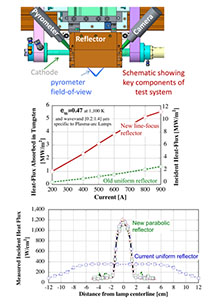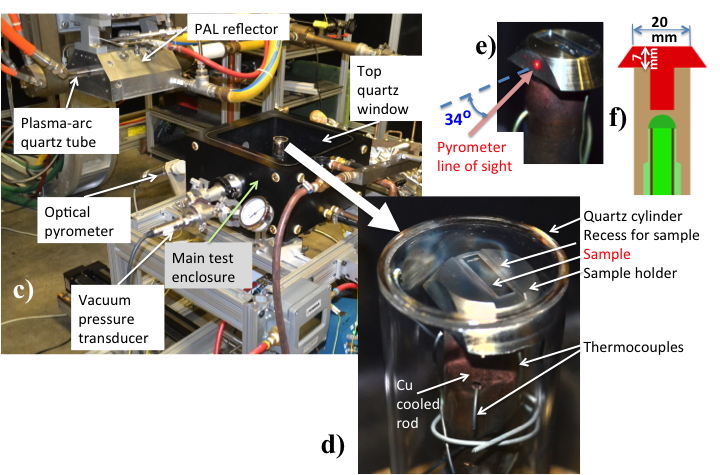The water-wall Plasma-arc Lamp (PAL) was developed at the University of British Columbia where a key innovation was to protect the quartz tube, which contains the plasma arc, from overheating by the 12,000 °C plasma temperature with a layer of water flowing in a spiral on the inside surface of the tube. PAL systems are currently designed and fabricated by Mattson Technologies, Inc., mainly for semiconductor applications. PAL was in the 1986 and 1993 Guinness Book of World Records as the most powerful continuously photon source at over 300 kW. At ORNL, PAL are used when high-heating rates, high-temperatures, and/or high-heat fluxes are required to either process new materials or test them under these severe environments. Areas of expertise with PAL include:
- Liquid-phase sintering of powder precursors for thin-gauge sheet fabrication (Ni, TiAl, Re)
- Annealing of Al, steels for preferential softening
- Fusion of spray coatings and claddings for corrosion and wear resistance (NiCr, WC/Ni-P, and Fe-29Cr on steel)
- Surface treatment of ceramics
- Anneling of complex oxides (e.g., ZnO)
- High-heat flux testing for fusion or aerospace applications in high-vacuum or low-vacuum
Capabilities of the Plasma-Arc Lamp Facility
The facility include various sensors to monitor process conditions during Infrared Processing using PAL. Sensors include high-vacuum pressure transducers, pyrometers, flowmeters, and a data acquisition system. The ORNL staff expertise include high-vacuum systems, design and fabrication of complex components to attain desired process conditions (temperature, thermal gradients, atmosphere control), materials science, infrared thermography, modeling of energy transport (spectral optical model, IR in semi-transparent media).
PAL Facility upgrade in 2017
In 2017, a new reflector was designed and fabricated to attain a source heat-flux of 11 MW/m2. The absorbed heat-flux in tungsten increased to 5.5 MW/m2 for high-number cycling tests). In addition, the new reflector was fabricated with two ports for monitoring the specimen condition during PAL processing/testing using pyrometers, IR camera, and/or video camera

ORNL successfully upgraded in 2017 the high-heat flux test capablity of the PAL Facility.
Test Sections for PAL Processing
The PAL facility provides the incident high-heat fluxes onto the specimen surface. However, appropriate test sections need to be employed according to each application. For example, refractories would require a high-vacuum test section due their poor oxidation resistance and high temperature. Coolant systems must be designed for each specimen geometry/configuration to attain specific temperatures and temperature gradients.

Example of a test section components for PAL including instrumentation and specimen holder.
Publications
| Facility Principal Investigator | Phone | |
|---|---|---|
| SABAU, Adrian S. | sabaua@ornl.gov | 865.241.5145 |
| IR Thermography | ||
| DINWIDDIE, Ralph B. | dinwiddierb@ornl.gov | 865.574.7599 |
| High-vacuum systems | ||
| KIGGANS, James O. Jr. | kiggansjojr@ornl.gov | 865.574.8863 |
| Design and Fabrication | ||
| SCHAICH, Charles R. | schaichcr@ornl.gov | 865.576.5581 |
| PAL Operator | ||
| MOORE, Daniel T. | mooredt@ornl.gov | 865.574.8863 |

